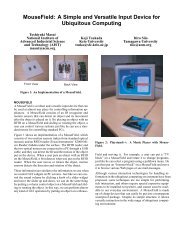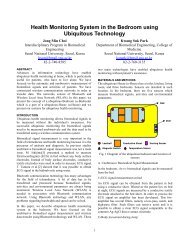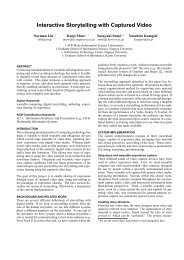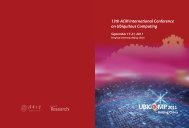SENSE OF PRESENCE: A SENSORIMOTOR ACCOUNTAn ineffable sense of selfAs noted in [1], a subset of the ’apparatus-based’ sensorimotorcontingencies (SMCs) relevant to the sense of visionmay derive from sensorimotor laws relative to an ’observeroriented coordinate system’. Learning these laws would providethe system with a rudimentary (enactive) notion of self.For instance, objects (or other people) generate stimuli thatcan be removed and put back into the visual scene, whilesensation about one’s own body is always potentially available.Furthermore, some parts of the perceived environmentcan be controlled at will (i.e. in a manner independent to themotion of the sensory apparatus) while others not (e.g. wedon’t need to look away in order to hide our own hand). Wecan generalize this claim as follows: things that are not ourselvesgenerate stimuli that can be removed or put back intothe visual, auditive or tactile scenes, while our own bodygenerates stimuli (including this time proprioceptive information)that cannot be so easily removed. Therefore a senseof self-location is brought by active exploration of the worldwith (implicit, practical) knowledge of the structure of egocentricsensorimotor contingencies. (If the observer was notphysically located in a particular place in space, these sensorimotorcontingencies would be of a very different nature;perhaps one day a robot with pervasive sensors and actuators- like HALL9000 supercomputer from ’2001: SpaceOdyssey’- will tell us what it’s like to have an ubiquitoussense of self).Sensorial awareness and sense of selfSMCs determined by the character of the ’sensory apparatus’would roughly correspond to the crude character of ’sensation’,while those related to the character of the exploredobjects would form the basis of ’perceived content’ [1]. Inother words, awareness of the character of the experience(is it visual, auditive or something else?) as well as understandingof its content (for the purpose of thought, planningand speech behavior) may be worked out by a concurrentneural mechanism responsible of recognizing and analyzingeach particular pattern of SMC. In fact, there may be differentlevels of ’understanding’ (each more or less accessibleto consciousness). At the top of the hierarchy, we may haveabstract knowledge relative to the occurrence of some formof sensory experience, as long as the SMC has some recognizable,familiar structure (perhaps learned late in life). Inother words, we may be aware of being experiencing somethingwithout paying attention to the actual content of theexperience. This could contribute to (or even form) a senseof self: if while actively exploring the world, familiar patternsof SMCs appear, then you may not only experiencesomething, but you may experience being a Self experiencingthat; if, on the other hand, you fail to recognize any patterns,then you may not just be sense-blind: you may noteven experience being someone at all.IDEAS FOR EXPERIMENTS AND PRACTICAL USESAltering in a controlled way the SMC pattern for a particularsensorial modality may be more or less easy to achieve (theinverted-glass experiment [11] is a classic example). However,altering in a controlled way all the sensorimotor contingenciesas well as their inter-relations (including time correlations)may be more difficult to do. To start with, the alteringdevice should be multi-modal. An immersive virtualreality environment could be an ideal setup, but the technologyfor haptic and proprioceptive actuators is not nearly asdeveloped as auditory or visual displays. For example, whileit is easy to set an inverted vision experiment, it is not so easyto conceive –left alone design– a setup for ’inverted haptics’:it would mean for instance than when touching somethingwith my right hand, I would feel the object on my left hand.Attentional self-ness for human computer interfacesAnother interesting consequence of this view is that it shouldbe possible to apply the same principles behind attentionalblindness (i.e. experiential blindness while retaining sensation)and induce attentional self-ness. It turns out that thismay be a normal occurrence in everyday life: we do performrepetitive tasks automatically, sometimes without even registeringin memory the fact that we did them. (In a sense, weare all philosophical zombies from time to time.) However,it would be interesting to be able to control this, perhaps inorder to reduce cognitive load from tasks that can be doneby a machine and don’t need attention from part of the user.Medical ApplicationsThe temporo-parietal junction seems to be the common lesionsite in patients suffering from disturbances of the egocentricspatial-relationship with extrapersonal space (a conditionalcalled visuospatial neglect). This is not surprisingif we believe the results reported in [8]: this region is infact very involved in the real-time integration of proprioceptive,tactile, visual and vestibular sensory input, generatinga three-dimensional, dynamic representation of the body inspace. Therefore, one can wonder if artificially manipulatingthese inputs may lead to some degree of control over theway the body is represented in space, for therapeutic or atleast for palliative care. An example related to this may bethe ’revival’ of phantom-limbs for the purpose of treating associatedpain [9]. Another interesting possibility may be thetreatment of higher cognitive dysfunctions, such as dissociativeidentity disorders; indeed, it has been found that OBEscorrelate in people with these disorders [8]. In short, we hypothesizethat the availability of a machine through whichone is capable of artificially creating and manipulating autoscopicimagery may render a sense of control over otherwisecontradictory or poorly organized sensorimotor feedback.Super mirrors?Perfectly reflecting surfaces capable of creating an image indistinguishablefrom reality is a relatively recent human inventionthat can be traced back to the first century AD [12].Yet it was a luxury object; Modern ubiquitous mirrors area much more recent invention Therefore one should be surprisedmore than not about how comfortably we seem to getalong with these artifacts. It is well known that most animalsdo not pass the ’mirror test’, and fall pray once and again tothe illusion of reflexions, so one has the right to wonder ifour getting used to these ubiquitous reflexions is not becauseof an intensive exposure in our daily lives (fun house mirrorsdo make us uncomfortable!). However, since a mirror breaks12
the natural egocentric visuospatial perspective, one can suspectthat their intrusion in the visual field may still disruptthe normal integration of visuospatial information. In fact,researchers have shown that the temporo-parietal region isactivated when one tries to mentally superimpose one’s bodyon a front-facing schematic human figures, while the sameregion is not activated when one observes back-facing characters[8]. It is like the mere idea of seeing oneself from anoutside perspective had a special experiential content – everydaymirrors may not be so innocent after all! Perhaps adevice that could give finer control of this disruption wouldbe more efficient or safer. This remark is particularly importantif one is to consider the use of mirrors on vehicles.A (wearable?) ’autoscopic super mirror’ could display a3d model of the observed/observer as seen from any arbitraryposition in extrapersonal space, and this position couldbe naturally controlled by the user after learning a properlydesigned artificial SMC scheme that would not disrupt thesense of self in a way that is counterproductive or dangerousfor the task at hand. In the future this may be achieved bymounting several cameras and reconstructing the scene froman arbitrary point of view. Uses of this could range from’enhanced mirrors’ for dancers that could see their own bodyfrom any location during rehearsal, to their use on cars, as anenhancement or substitute of the front and rear mirrors (thiscan be achieved by collecting images from street cameras orfrom cameras mounted on other cars, or more simply by usinga unique fish-eye camera could be mounted high on thecar). Research on telexistence systems is solving part of theproblem [13]; indeed, these ’super mirrors’ are autoscopictelexistence systems.CONCLUSION AND FURTHER WORKThe system described in this paper tampers with two of thesensory stimuli that seems directly involved in the constructionof body self-awareness, namely visuospatial input aswell as a limited form of tactile feedback. This experimentdoes seem to generate a mild form of OBE (or at least thefeeling of being in a ’twilight zone’ and that without careone can be induced an OBE - and be absorbed by the box). Amore objective study is needed in order to asses the efficacyof the illusion, but this was not the goal at this stage of theexperiment. In this paper we have deliberately concentratedon a rudimentary notion of the self, one that could accountat least for some form of body self-perception. Borrowingthe terminology of the sensorimotor contingency model, wemay say that being-in-the-body is a way of acting on objectsin the world. OBEs would result from the alteration of normalsensorimotor dependencies as well as cross-modal dependencies.(This view suggests that synesthesia and out-ofbodyexperiences may be co-morbid phenomena, a view forwhich there seems to be some medical evidence [14]). If thisalteration is consistent in time (something that could be donewith the help of ’device that alters perception’ more complexthan a movable mirror for instance), then one can expect thata functional sense of self could be regained once one comesto grips with the new set of artificial SMCs. This may indeedhappens in everyday circumstances. For instance, weusually don’t experience any severe disturbance of the senseof self when looking at a mirror, nor is our self disintegratedwhen playing a first-person shooter game. There may befundamental reasons for that immunity (such that too fewsensorial modalities are involved in these experiments), butit may also be that we have learned enough about these abnormalsituations so as to ’flip’ the whole set of sensorimotorcontingencies, and tune to the one that makes more sense (abistable form of adaptation similar to the one observed inthe limited-time inverted glasses experiment [11]). In anycase, it would be interesting to design a device capable of adeeper alteration (although controlled and consistent) of thewhole scheme of sensory motor contingencies. A first concretestep would be to include some form of synchronizedvisuo-tactile stimulation in our own experiment; however,instead of passive stimulation as in [4], it would be interestingif the participant could be himself at the origin of thestimulation. For example, the box could have an opening fora hand, through which the participant would reach the headof his avatar; at the same time, some actuator would touchthe real head. Another idea would be to set the whole installationon a moving platform that would tilt as the user tiltsthe box in his hands, thus instantiating a form of vestibularfeedback.ACKNOWLEDGMENTThe first author would like to thank Arnaud de Grave,Stephane Perrin and Pablo Gindel for inspiring discussionsthat set the mood for the experiment, as well as to CarsonReynolds for interesting commentaries.REFERENCES1. A. Noe, Action in Perception, The MIT Press (2004).2. D. Dennett, Consciousness Explained, Penguin (1991).3. F. J. Varela et al., The Embodied Mind, MIT (1991)4. H. H. Ehrsson, The Experimental Induction of OBEs,Science, 317(5841): 1048 (2007)5. www.k2.t.u-tokyo.ac.jp/members/alvaro/boxedEgo6. O. Blanke and G. Thut, Inducing OBEs, Ch.26, TallTales about Mind and Brain, (2006)7. CM. Cook and MA. Persinger, Experimental inductionof the ”sensed presence”. Percept. Mot. Skills.85(2):683-93 (1997)8. O. Blanke, OBEs: Psychological and neurologicalcharacteristics, Proc. 5th Symp. of the Bial Foundation.9. Ramachandran, V. S. and S. Blakeslee, Phantoms in thebrain, William Morrow Co. (1998)10. H. H. Ehrsson et al., Touching a Rubber Hand,J.ofNeurosc. 25(45):10564-10573 (2005)11. J. G. Taylor, Behavioral Basis of Perception, Yale Univ.Press, (1962)12. S. M. Bonnet, The Mirror: A History, Routledge (2001)13. K. Watanabe et al., TORSO: completion of egocentrictelegnosis system, SIGGRAPH (2007)14. HJ. Irwin, Correspondence. J Soc Psych Res,51:118-120, (1981)13
- Page 3 and 4: We would also like to extend a spec
- Page 5 and 6: ∙ USE‐03 Clinical Proof‐of‐
- Page 7 and 8: Ubiquitous Sustainability: Citizen
- Page 9 and 10: Devices that Alter Perception (DAP
- Page 11 and 12: incorporated into the body; if it d
- Page 13 and 14: vise. Beginning improvisers typical
- Page 15 and 16: Location-based Social Networking Sy
- Page 17 and 18: PrivacyWith any social networking a
- Page 19: BOXED EGO INSTALLATIONA pair of cam
- Page 23 and 24: HUMAN SENSES AND ABSTRACT DANGERSOu
- Page 25 and 26: Gesture recognition as ubiquitous i
- Page 27 and 28: een developed to overcome this. For
- Page 29 and 30: 16. Myvu Corporation. Myvu Crystal.
- Page 31 and 32: especially in the fields of Ambient
- Page 33 and 34: 14. G. Riva (Editor), F. Vatalaro (
- Page 35 and 36: system, reflex arcs, and even muscl
- Page 37 and 38: 5. R. Cytowic. Synesthesia: Phenome
- Page 39 and 40: RELATED WORKLet us consider the loc
- Page 41 and 42: (a) Actual traces.(a) Actual traces
- Page 43 and 44: Figure 2. Schematic picture of the
- Page 45 and 46: notion of partial/total immersion w
- Page 47 and 48: A Quantitative Evaluation Model of
- Page 49 and 50: a group of users. We, therefore, in
- Page 51 and 52: During the above discussion, user g
- Page 53 and 54: Usability Study of Indoor Mobile Na
- Page 56 and 57: 11%3%0%0%30%19%5%3%0%11%56%Notifyed
- Page 58 and 59: CONCLUSIONFor this study, we have d
- Page 60 and 61: are suited to provide sufficient cl
- Page 62 and 63: attention to your blood pressure re
- Page 64 and 65: invested in final development and c
- Page 66 and 67: 4. rhythms - the highly predictable
- Page 68 and 69: technologies, especially their coll
- Page 70 and 71:
Situvis: Visualising Multivariate C
- Page 72 and 73:
all. A user selecting a range withi
- Page 74 and 75:
constraints to include traces that
- Page 76 and 77:
Simulation Framework in Second Life
- Page 78 and 79:
VirtualEmitterEstimatedPositionVirt
- Page 80 and 81:
odies) then our approach would faci
- Page 82 and 83:
Design and Integration Principles f
- Page 84 and 85:
asis for interaction, it focuses on
- Page 86 and 87:
to support POST and GET messages as
- Page 88 and 89:
senor node’s functionalities in a
- Page 90 and 91:
service model and provide paradigms
- Page 92 and 93:
Virtualization of resources will fa
- Page 94 and 95:
Figure 3. Heating and lighting cont
- Page 96 and 97:
sat down at the same time” can be
- Page 98 and 99:
10!; !< !=!"#$%&’"()%* +$(%,-’#
- Page 100 and 101:
posite event operators such as conj
- Page 102 and 103:
objects? If these particles were sm
- Page 104 and 105:
Over-the-air-programmingOTAP (Over-
- Page 106 and 107:
Randomised Collaborative Transmissi
- Page 108 and 109:
Figure 2. Illustration of periodic
- Page 110 and 111:
Figure 3. Illustration of the recei
- Page 112 and 113:
Experimental Wired Co-operation Arc
- Page 114 and 115:
The structure of network is matrix
- Page 116 and 117:
Altera Quartus II v7.2SP3 FPGA soft
- Page 118 and 119:
Using smart objects as the building
- Page 120 and 121:
To the ambient ecology concepts des
- Page 122 and 123:
event. A more complicated approach
- Page 124 and 125:
Multi-Tracker: Interactive Smart Ob
- Page 126 and 127:
interfacing with whole space, but c
- Page 128 and 129:
operate interactions by many partic
- Page 130 and 131:
An Augmented Book and Its Applicati
- Page 132 and 133:
its withy material. So, the movemen
- Page 134 and 135:
Table 1. The Performance of Page Fl
- Page 136 and 137:
Ambient Information SystemsWilliam
- Page 138 and 139:
We, too, believe there is a certain
- Page 140 and 141:
management system and forwarded to
- Page 142 and 143:
CONCLUSIONWe have presented the des
- Page 144 and 145:
Ambient interface design for a Mobi
- Page 146 and 147:
as ‘sensitive’ and filtered awa
- Page 148 and 149:
Ambient Life: Interrupted Permanent
- Page 150 and 151:
The log files revealed the actual r
- Page 152 and 153:
Stay-in-touch: a system for ambient
- Page 154 and 155:
Figure 1. The Stay-in-touch display
- Page 156 and 157:
User Generated Ambient PresenceGerm
- Page 158 and 159:
Figure 3: Cross-platform system tra
- Page 160 and 161:
The Invisible Display - Design Stra
- Page 162 and 163:
On a more general level Mimikry cre
- Page 164 and 165:
Rand in fact few examples of public
- Page 166 and 167:
Ambient Displays in Academic Settin
- Page 168 and 169:
usefulProfiles 22 (37%)Time and dat
- Page 170 and 171:
UTILIZE THE POTENTIAL TO FULLEST: D
- Page 172 and 173:
A notification system for a landmin
- Page 174 and 175:
As for the investigation phase, whe
- Page 176 and 177:
Ubiquitous Sustainability: Citizen
- Page 178 and 179:
Live Sustainability: A System for P
- Page 180 and 181:
(a) (b) (c)Figure 3. Screenshot for
- Page 182 and 183:
Motivating Sustainable BehaviorIan
- Page 184 and 185:
dialog with policy makers and servi
- Page 186 and 187:
5. Fogg, B. J. (2002). “Persuasiv
- Page 188 and 189:
on mode of transportation such as t
- Page 190 and 191:
In order to be useful, PET requires
- Page 192 and 193:
provides a relevant description and
- Page 194 and 195:
Star, L. S., The Ethnography of Inf
- Page 196 and 197:
door environment, the accuracy of G
- Page 198 and 199:
Figure 5. Variations of “Parasiti
- Page 200 and 201:
can view where it has been, who ans
- Page 202 and 203:
Nevermind UbiquityJeff BurkeCenter
- Page 204 and 205:
innovating within existing capacity
- Page 206 and 207:
Since the Brundlandt report a serie
- Page 208 and 209:
our current research in mobile gami
- Page 210 and 211:
conceive only of human-computer int
- Page 212 and 213:
human behaviour will encounter. The
- Page 214 and 215:
mental models of the world are test
- Page 216 and 217:
alternative, the place that could h
- Page 218 and 219:
elow the mode button indicate the c
- Page 220 and 221:
212
- Page 222 and 223:
digital collection of features to a
- Page 224 and 225:
immediately followed by a subset of
- Page 226 and 227:
forecast the future accesses to tho
- Page 228 and 229:
Enhanced and Continuously Connected
- Page 230 and 231:
than two application windows execut
- Page 232 and 233:
Secure and Dynamic Coordination ofH
- Page 234 and 235:
AudioProducer/ConsumerVideoConsumer
- Page 236 and 237:
228
- Page 238 and 239:
MotivationsMotivations occurred on
- Page 240:
Kray Christian ··········






